Family : Nymphalidae

Texte © Dr Didier Drugmand
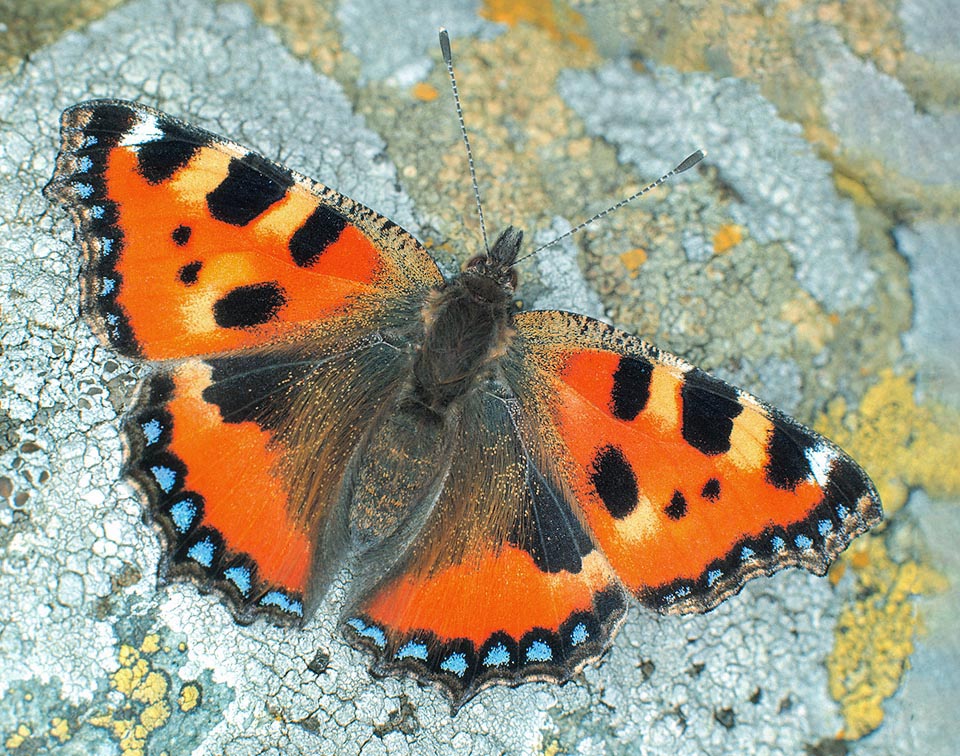
Aglais urticae is one of the first butterflies to reappear at the end of winter and one of the most common European butterflies with a wingspan of 40-62 mm © G. Mazza
Aglais urticae or Small Tortoiseshell is one of the first butterflies to reappear as soon as the sunny days, at the end of winter. It is also one of the most common butterflies in Europe.
The species was named after the Swedish naturalist K. von Linné, who described it in 1758 in a few Latin words. He placed it in his genus Papilio within the group of Nymphalis gemmati, or eye-spotted nymphs. The Small Tortoiseshell is known today under the scientific name of Aglais urticae (Linnaeus, 1758).
Aglais is a genus of Rhopalocera (= butterfly) of the rich family Nymphalidae, which includes nearly 6150 species, widely distributed throughout the world. It was created by the Swedish naturalist Johan Wilhelm Dalman in 1816. Today, it includes three species distributed north of the equator. The type species is the one we are interested in on this page: Papilio urticae Linnaeus, 1758.
Let’s start with a few words about its etymology. The name of the genus refers to Aglaia, (in ancient Greek Αγλαΐα) one of the three Charites, the one that personifies amazing beauty, the splendour. Urticae comes from the Latin urtica, which means the one that burns, the nettle, the plant on which caterpillars feed.
French speakers know it under the name of « Petite Tortue », but also as “Vanesse de l’Ortie” or even “Petit-Renard”, the Germans as “Kleiner Fuchs”, the Italians call it “Vanessa dell’ortica” and the Spanish “Ortiguera” or “Mariposa de la Ortiga”.
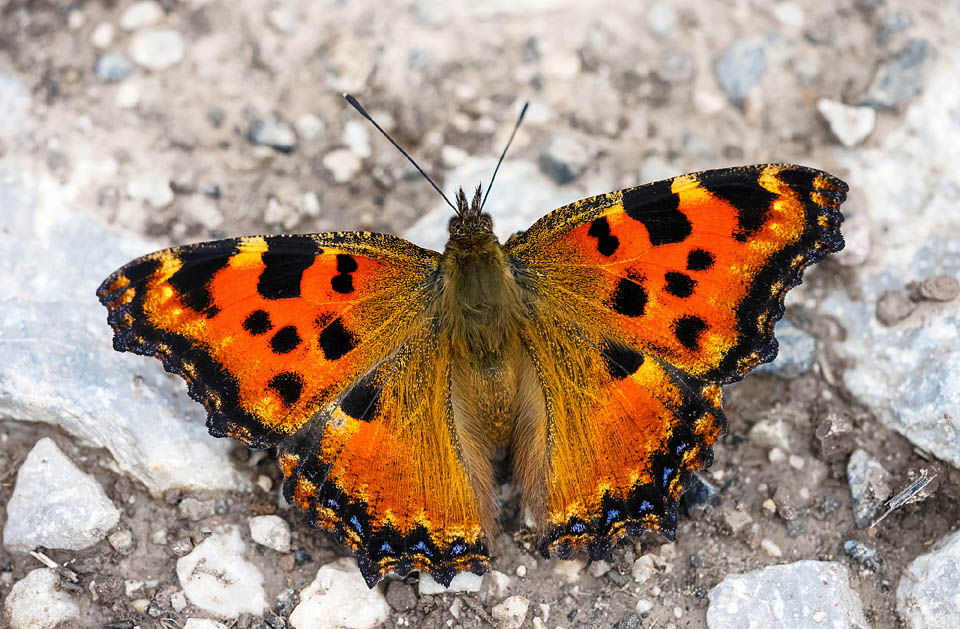
The Large tortoiseshell (Nymphalis polychloros) is very close to the Small Tortoiseshell, it differs from it in particular by the 4 black spots in the center of the front wings © Adam Gor
René-Antoine Ferchault de Réaumur, in 1734, in his “Mémoires pour servir à l’Histoire des Insectes” (Memoirs to serve the History of Insects), provided the explanation of the name “Tortoise” used in French and in English : “because of the distribution of its colours, which imitates to some extent those of the spots of the tortoise shell”.
In Europe, three subspecies have been described: 1- A. urticae urticae (Linnaeus, 1758), the nominate subspecies living in Europe, Western Siberia and the Altai Mountains, 2- A. urticae polaris (Staudinger, 1871) in Northern Europe, Siberia and Eastern Russia, and 3- A. urticae turcica (Staudinger, 1871) in Southern Europe, the Caucasus, Transcaucasia, and Central Asia. Note that the species endemic to Corsica and Sardinia Aglais ichnusa (Hübner, 1824), very similar to A. urticae, is still the subject of debate as to its status as a species or subspecies.
Zoogeography
This Eurasian species is one of the most common in Western and Southern Europe. The Small Tortoiseshell, although very widely distributed, would be, for a few years, everywhere less abundant, in the Northern European countries. To explain this tendency to rarefaction, some scientists have put forward the hypothesis of a consequence of global warming, pushing certain particularly mobile populations, which can tolerate a rather narrow range of temperatures, to frequent more and more high-altitude regions to the detriment of the lower regions.
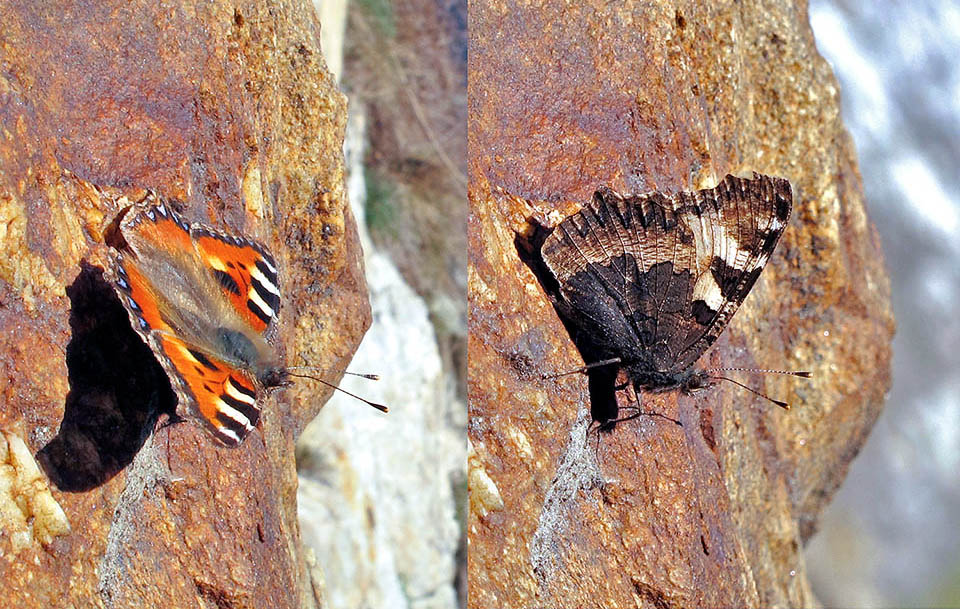
The coloration and patterns of the wings of Small Tortoiseshell often allow them to escape from their predators. When closed, their wings look like dead leaves. On the ground, most of the birds take generally up to 30 minutes to locate them. When they are discovered, they open their wings and suddenly reveal their bright colours. By surprising the attackers have ample time to escape. Moreover, the bright red colouring indicates to the predator the unpleasant taste of the butterfly © Vincent Baudraz
It also happens that the populations of Small Tortoiseshell disappear completely for one or more years to reappear then. This pseudo-cycle seems directly related to the hygrometry more than to the important heat, its host plant, the nettle, needing a lot of water to develop optimally, especially at the beginning of spring. Certain parasitoids (see below) also limit its populations.
Habitat and Ecology
In order to select the plant that they will preferentially forage, the adult of Small Tortoiseshell base themselves first on the floral scent, an important signal to identify and, subsequently, recognize and distinguish the flower among the other plants flowering at the same moment. Like the other Nymphalidae, the proboscis of Aglais urticae is relatively long, this characteristic allows it to visit the flowers with deep corolla such as Buddleja davidii, Cirsium…
Aglais urticae grows in a wide variety of environments where stinging nettle (Urtica dioica) grows : wet wasteland, stream banks, paths and forest edges, gardens, wasteland and old dumps. In the mountains, the populations are concentrated around open land, which is highly anthropized: embankments, tracks, chalets, sheepfolds and pastures. Highly floriferous, the adult frequents a multitude of nectariferous plants such as coltsfoot and willow kittens in early spring to the last asters in autumn in gardens.
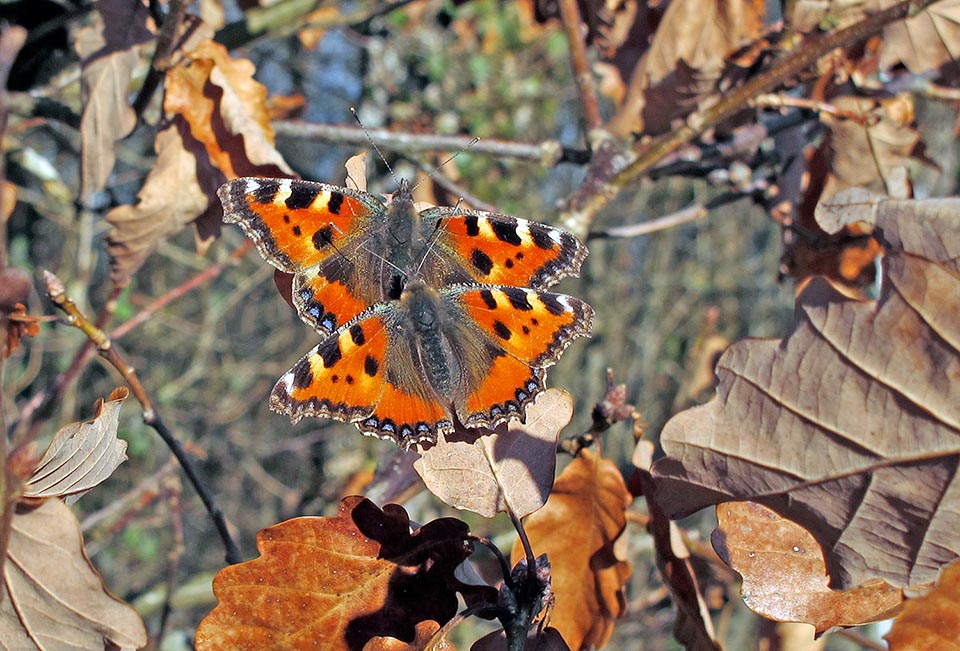
A courtship display. Mating usually starts at dusk under a bush and lasts all night © Vincent Baudraz
At the end of the summer, the second (or even third) generation of Small Tortoiseshell often forage in the flowered areas of the countryside, where they gather to feed with predilection on the nectar of thistles, then on the ragwort and other Asteraceae. They also frequently visit gardens, where they are strongly attracted to daisies, Sedum, Buddleja… During this period of the year, they feed on nectar, accumulating enough reserves of proteins and fats in their body to enable them to survive hibernation.
The caterpillars feed on the leaves of the stinging nettle (Urtica dioica), but also, according to some Anglo-Saxon authors, on a fewer common species, the annual nettle (Urtica urens).
Morphology
The eggs are light green in colour and ovoid. They are furrowed over their entire length by clear lines, more or less parallel, joining at the two poles. This instar takes between 8 and 13 days.
The first instar caterpillars have black heads and prothorax. The rest of the body is largely light yellow, with vertical bristles scattered on each segment. The caterpillars begin to darken from the second instar with broad black stripes alternating with yellow lines. Long, harmless (to us) spines, gathered in tufts, stand out around the circumference of each ring. In its 5th and final instar, the caterpillar reaches a maximum length of 45 mm. The larval cycle lasts three to four weeks (13 to 25 days).
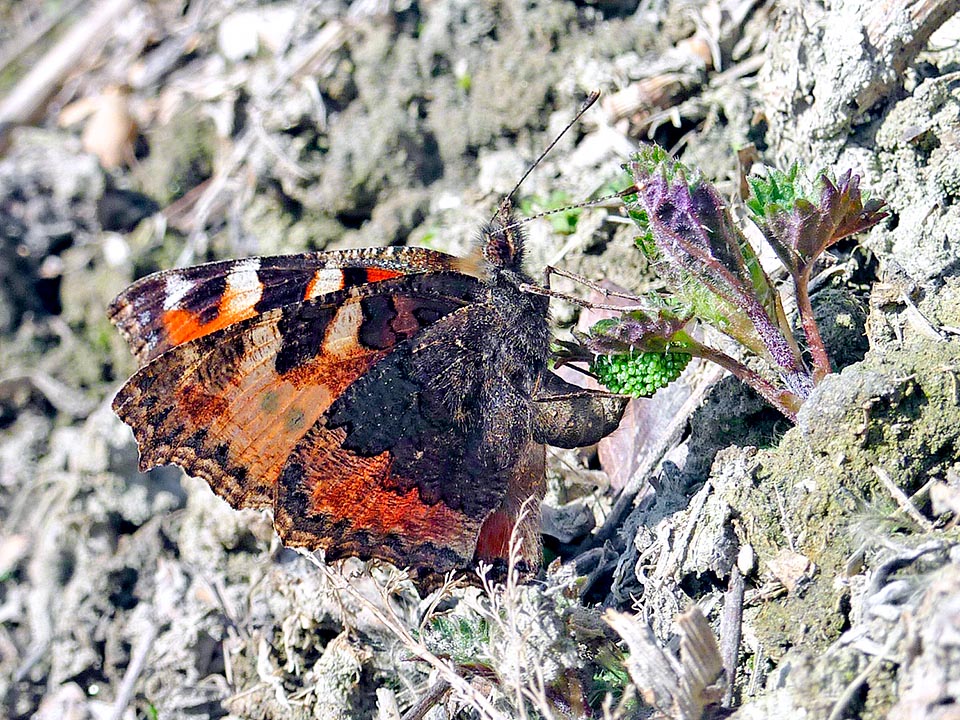
Females lay clusters of 80-100 eggs, more or less stacked, mainly on the underside of Urtica dioica leaves. Oviposition lasts between 20 and 90 minutes © Vincent Baudraz
When they reach maximum growth, the late instar larvae disperse and eventually move away from the stinging nettle to find a suitable pupation site. The pupae vary in colour from grey to olive or buff, often with a pinkish or golden metallic sheen. Its length fluctuates between 20 and 22 mm. It is found upside down, hanging by the cremaster, from woody stems, fence posts, walls or under nettle stems or leaves. Adults emerge at dawn, about 8 and 18 days after pupation begins.
This butterfly, without sexual dimorphism, has a wingspan of between 40 and 62 mm for a body length of 22 to 28 mm. On the orange-red background of the upper side of the wings, three black costal spots stand out, separated by two yellow ones and one white one towards the apex. In the middle of the wing, 3 other black spots of varying shape and intensity. The forewings and hindwings have a series of blue spots on the outer margin of the forewing and hindwings, surrounded by black. The underside of the wings is rather dull, coloured blackish brown and ochre, possibly suggesting dead bark or leaves. The body is dark brown and hairy. The eyes are also dark. The antennae are finely striated with white and have a white dot at the tip.
Note that its habitus is close to that of the Large Tortoiseshell (Nymphalis polychloros (Linnaeus, 1758)), but the latter is slightly larger (hence its name), without a white spot on the apex of the forewings with the wings of a more yellowish and duller tawny, without a large black spot at the base of the upper side of the hindwings, with 4 spots in the middle of the forewings (compared to 3 in the Little Tortoiseshell) and, especially, entirely dark brown on the underside of the forewings.
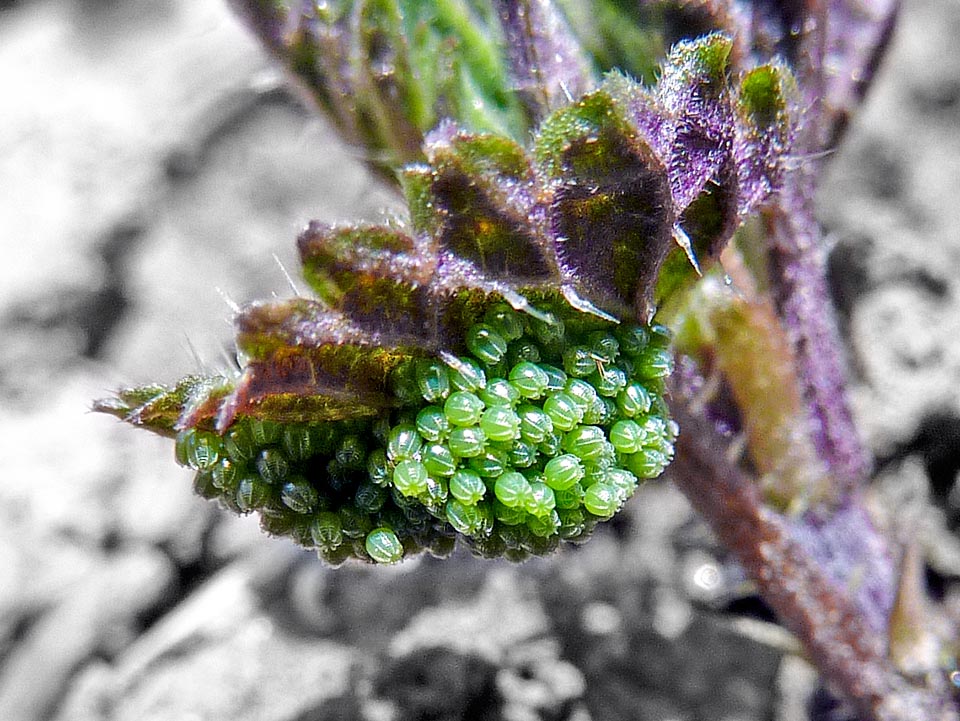
Eggs hatch after 1-3 weeks. Aglais urticae has 2-3 generations in Southern and Western Europe, but 1 generation in the coldest regions © Vincent Baudraz
Ethology-Reproductive Biology
Cycle
Females lay clusters of 80 to 100 eggs, more or less stacked, on the underside of nettle leaves (mainly on stinging nettle (Urtica dioica), which often grow in warm, sunny, sheltered locations. Note that several females can lay eggs on the same nettle plant.
The Small Tortoiseshell adapts its oviposition to the sanitary state of the nettle, the better it is, the more important the oviposition will be. The oviposition lasts between 20 and 90 minutes.
The eggs hatch then between approximately one and three weeks. Immediately after hatching, the larvae devour the empty shell, then weave a silk web around the terminal leaves of the nettles. They take shelter in this web at night or in bad weather and feed eagerly as soon as the sun shines. As they grow, the larvae move on to other plants, building new webs along the way.
When disturbed, the caterpillars react in unison, twisting and shaking to defend themselves, especially against wasps or parasitoid flies. When attacked, the caterpillars sometimes regurgitate a green liquid and, if necessary, curl up into a ball and drop to the ground.
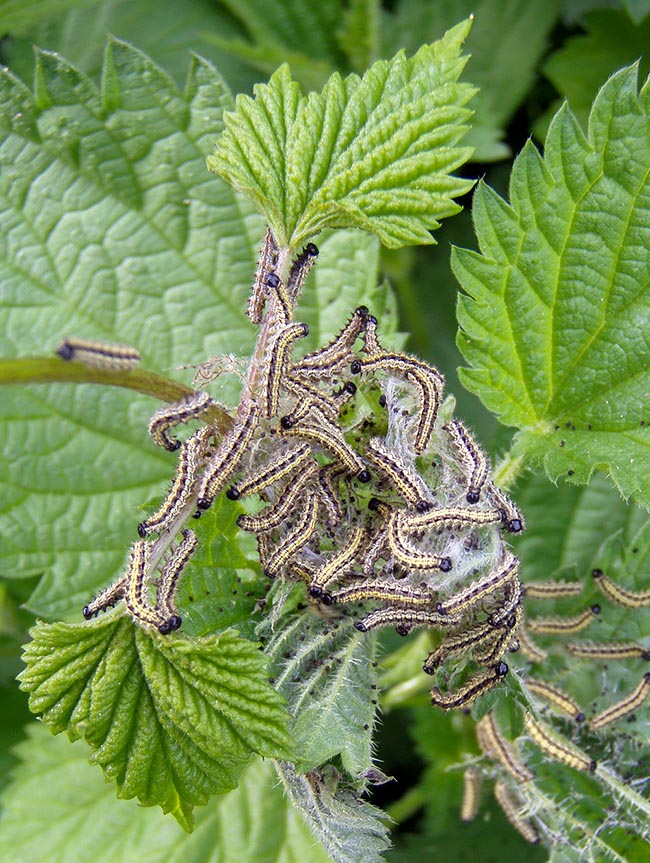
Immediately after hatching, the caterpillars devour the empty shell, then weave a silk web around the terminal leaves of the nettles. They take shelter in this web at night or when the weather is bad © Vincent Baudraz
Caterpillars feed day and night. They become solitary after their fifth and final moult.
The adults overwinter in tree cavities, between the stones of old walls or in old buildings. They are active from the first sunny days of spring.
The Small Tortoiseshell is often polyvoltine with 2 or 3 generations in Southern and Western Europe, but univoltine in the coldest regions.
It is one of the Eurasian butterflies with the longest activity, from early spring to late autumn.
Overwintering adults emerge from dormancy as early as late February in mild weather, or more generally in late March or early April.
They are then active from March to October.
The adults live as single individuals, feeding on the nectar of various flowers, often located near nettles.
On cool spring days they warm up by shivering their wings before flying.
The rapid shivering generates frictional energy that allows the butterfly to fly away.
On warm days, they bask on the bare ground or on low foliage, with closed wings, the dark colour of the underside of the wings provides excellent camouflage against predators.
The Small Tortoiseshell tends to go into hibernation between mid-September and the end of October.
This butterfly usually hibernates in dark, sheltered places.
Before this dormant stage, it accumulates a lot of fat (lipids) to survive the winter, its body weight increases by about 20%. This overweight slows down its movements and the butterfly is easily caught by the birds. Up to 50% of the population can then be eaten. Butterflies that hibernate in less dark areas are sometimes also eaten by small mammals that look for them on the bark of trees, for example. During hibernation and in sheltered areas, these butterflies can withstand temperatures as low as -21 degrees Celsius without freezing. They lose weight rapidly during exceptionally mild winters, during which they wake up and can fly away for varying lengths of time. These untimely awakenings affect their survival and even their reproduction in the spring.
Courtship display and mating
The males establish observation points in the early afternoon, from where they wait for the females to cross. When a female passes by, it is intercepted, and the courtship begins. The male pursues the female until it lands on the ground. If the female is receptive, it opens its wings and the male approaches it from behind with its wings open. It then approaches its hind wings, which he taps vigorously with its antennae. The pair then flies a short distance and repeats the process. Any other male that tries to interfere is quickly chased away by the resident male, who then returns to its female to continue flapping its wings.
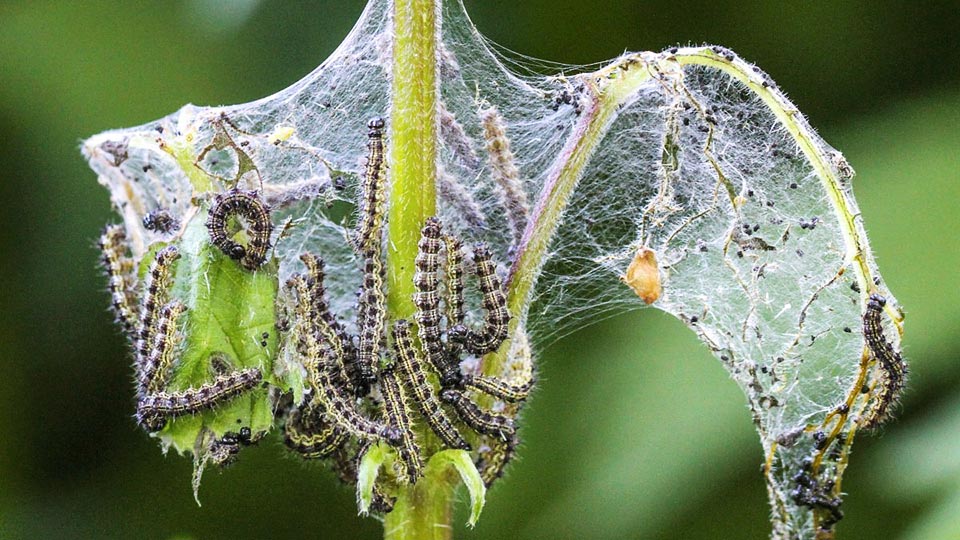
They feed voraciously as soon as the sun is shining. While growing, they move to other plants, building new webs © Daniel Ventard
This courtship continues for several hours, until the female accepts the male’s advances just before dusk. At this point, it leads the male to a sheltered, shady spot, usually under a shrub or hedge. Both sexes then hold their wings in the air, and the male walks beside the female, then bends his abdomen to copulate. After about 20 minutes, the pair stands up and turns in opposite directions. They remain mated in this position until the next morning.
Migration
To meet their different needs, Small Tortoiseshell must exploit a range of different habitats in the course of a day. Places that are suitable for resting or sunbathing are generally not suitable for eating or laying. Each time the butterfly changes its activity, it is likely to have to move around.
If the resources of its environment decrease significantly, the butterfly will also change locations to continue its activities. Such migrations take place several times a day. But since the butterfly uses a simple rule of orientation: always take the same route in relation to the sun, its movements are generally towards previously unvisited areas. Thus, the Aglais can cover considerable distances in a series of short, uncalculated migrations.
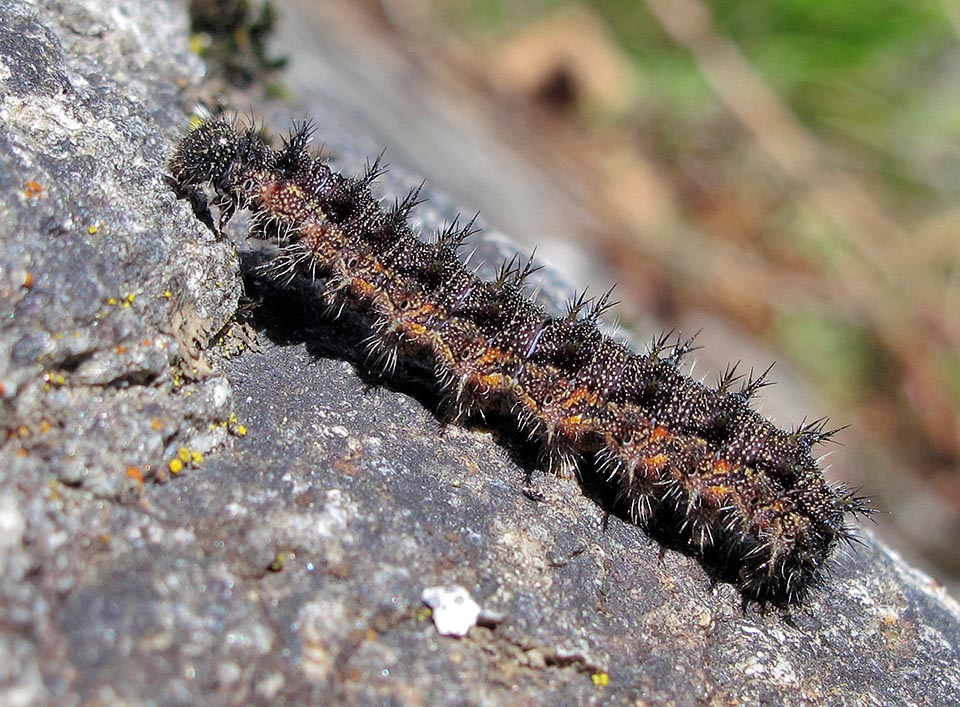
When they reach their maximum growth, the last instar caterpillars disperse to find an appropriate pupation site © Vincent Baudraz
Attacks and threats
Although the species does not appear to be threatened, the large multi-year fluctuations in its populations raise questions. It seems that in the plains, the Small Tortoiseshell suffers from the summer hydric deficit, which would explain at least partly these variations in numbers. Aglais urticae is seriously affected by droughts, the butterfly then experiences a very reduced reproduction rate. It should be noted that drought directly affects the nettle leaves and that the lower the level of nitrogen and water in the leaves, the slower the growth of the larvae will be. During a drought, these two levels drop significantly, leaving the caterpillars of this species with a poor-quality food source. If there is not enough rainfall in early summer, nettles will suffer and will not develop fully, reducing the resource available to the caterpillars. The butterflies will then reduce their egg-laying.
The host plant of the Small Tortoiseshell, the nettle, remains very common in many habitats. However, its stinging hairs often make it unloved by many city dwellers who eliminate it from their gardens. It should also be noted that the development of certain invasive plants, such as the Japanese knotweed (Reynoutria japonica), locally compromises the maintenance of hydrophilous tall herb fringe with nettles. These reductions in the number of nettles weaken the populations of the Small Tortoiseshell.
Aglais urticae also shows strong interannual fluctuations in abundance, which can be linked to the activity of parasitoids (Sturmia bella, a tachinid fly); low densities of adults of Aglais urticae generally appear after years with high parasitism.
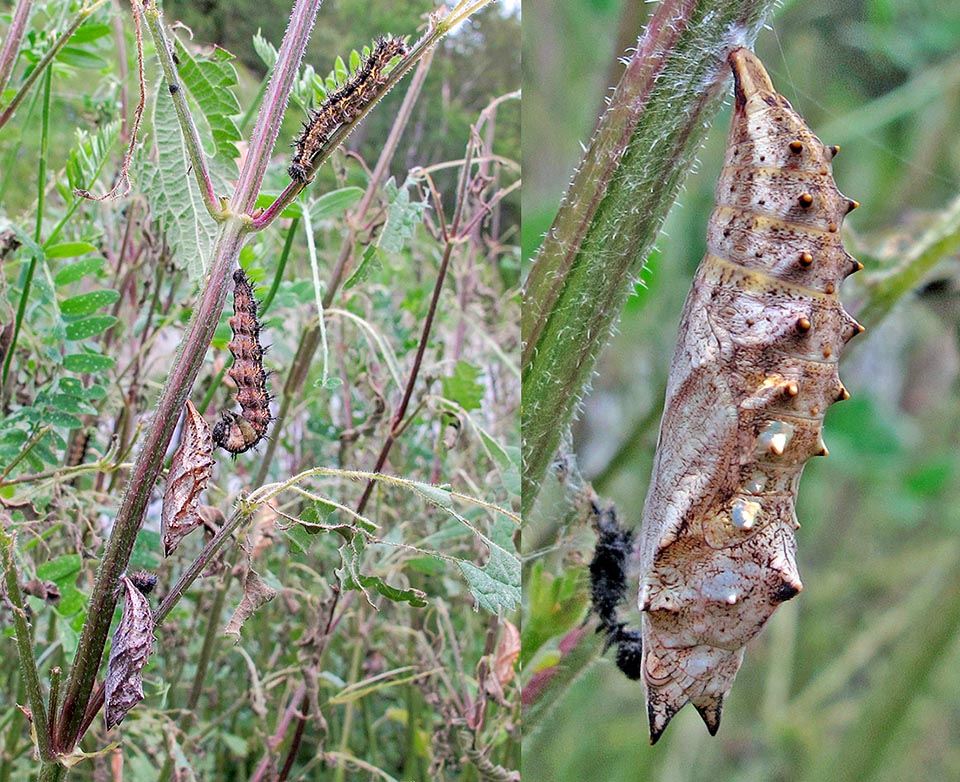
The chrysalis of the Small Tortoiseshell is very variable in colour, from grey to olive or buff, often with a pinkish or golden metallic sheen. Its length fluctuates between 20-22 mm. It is found upside down, attached by the cremaster to woody stems, fence posts, walls or under stalks or nettle leaves. Adults emerge at dawn © Vincent Baudraz
Defense against predators
The coloration and patterns of the wings of the Small Tortoiseshell often allow them to escape from their predators. When closed, their wings look like dead leaves. On the ground, birds take up to 30 minutes to locate them. When they are discovered, the Small Tortoiseshell open their wings sharply and suddenly reveal their bright colours surprising their predators. This behaviour gives the butterfly ample time to escape, and it quickly flies away in a straight line. Not only does this (aposematic) coloration tend to frighten birds, but it can also serve as a warning. The bright red coloration indicates to the predator the bad taste of the butterfly and limits its predation.
Management guidance and conservation measures
We can only encourage the cessation of the use of herbicides and the end of systematic warfare against nettle, particularly in private gardens where the species can find refuge. The maintenance of flowering patches, including in gardens, encourages the presence of adult butterflies. The control of invasive plants, although complicated where they are already well established, is also a conservatory measure to be recommended. A real ecological trap, the Buddleja davidii feeds the butterflies, but not their caterpillars, which it poisons with its leaves that contain toxic molecules, notably aucubin. Planting nettles near this invasive plant, which many gardeners appreciate for its large and beautiful flowers that attract numerous butterflies, will provide food and shelter for caterpillars of the Small Tortoiseshell (and several other butterfly species). Finally, the nettle serves as food for many other common species of Nymphalidae such as Aglais io (European peacock), Vanessa atalanta (Red Admiral), Vanessa cardui (Painted lady), Araschnia levana (European map or map), Polygonia c-album (Comma) …
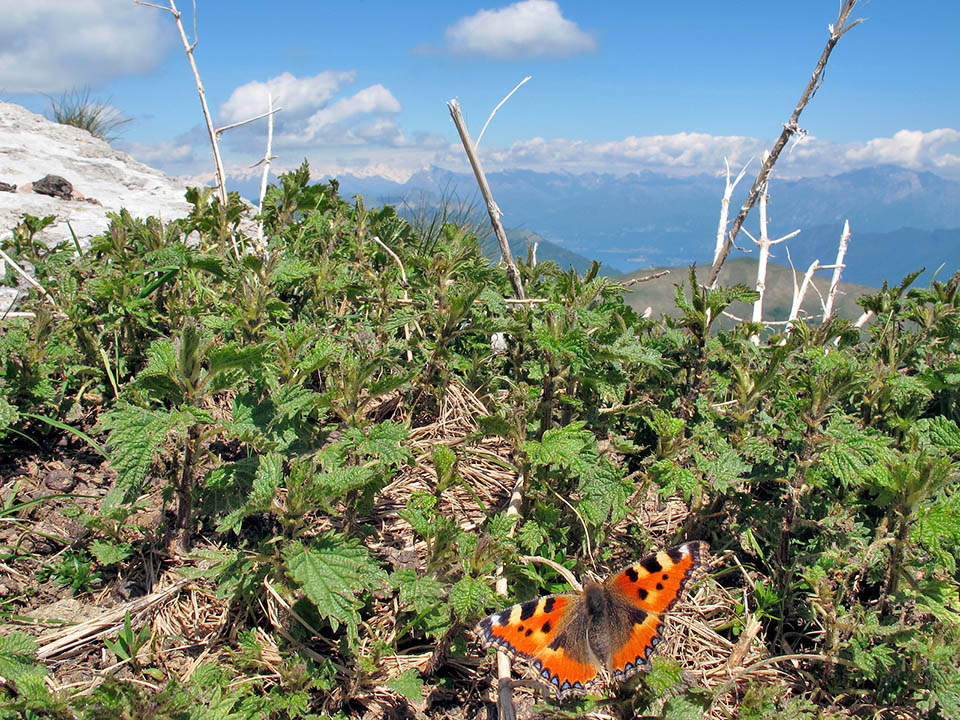
To meet their different needs, the Small Tortoiseshell must exploit a range of different habitats in the course of a day. Places that are suitable for resting or sunbathing are generally not suitable for eating or laying eggs. Although its populations vary greatly from year to year, this species is not endangered today © Vincent Baudraz
Synonymes
Aglais adumbrata Raynor, 1909; A. alba Raynor, 1909; A. angustibalteata Raynor, 1909; A. brunneoviolacea Raynor, 1909; A. caerulapicata Raynor, 1906; A. clarirufa Raynor, 1909; A. costadivisa Groenendijk, 1966; A. costajuncta Lempke, 1956; A. cuneatiguttata Raynor, 1909; A. expansa Groenendijk, 1966; A. fasciata Reuss, 1909; A. flavotessellata Raynor, 1909; A. fulva Raynor, 1909; A. fulvomarginata Raynor, 1909; A. griseomarginata Raynor, 1909; A. ignea Raynor, 1909; A. implumis Watkins, 1942; A. infraradiata Raynor, 1909; A. infuscata Raynor, 1909; A. ioformis Reuss, 1909; A. ioprotoformis Reuss, 1909; A. latericolor Raynor, 1909; A. latibalteata Raynor, 1909; A. lutea Raynor, 1909; A. maculomissa Goodson, 1959; A. magniguttata Raynor, 1909; A. magnilunulata Raynor, 1909; A. magninotata Raynor, 1909; A. magnipuncta Raynor, 1909; A. nigra Tutt, 1896; A. nigricostata Raymopr, 1909; A. nigridorsata Raynor, 1909; A. nigrimarginata Lempke, 1956; A. nubilata Raynor, 1909; A. obscura Raynor, 1909; A. ochrea Debauche, 1933; A. parviguttata Raynor, 1909; A. parvilunulata Raynor, 1909; A. parvinotata Raynor, 1909; A. parvipuncta Raynor, 1909; A. polychloroides Raynor, 1909; A. pseudoichnusa de Sagarra, 1930; A. punctijuncta Raynor, 1909; A. radiata Raynor, 1909; A. rubrochrea Raynor, 1909; A. salmonicolor Raynor, 1906; A. strandi Verity, 1936; A. strigata Raynor, 1909; A. subtusbrunnescens Groenendijk, 1966; A. subtuslactea Raynor, 1909; A. subtusnigrescens Lempke, 1956; A. subtusochreabalteata Reuss, 1910; A. subtusrufa Raynor, 1909; A. subtusvenata Lempke, 1956; A. teruelensis Sheldon, 1913; A. tripuncta Raynor, 1909; A. unipuncta Raynor, 1909; Alglais testudinea Raynor, 1909; Nymphalis urticae Linnaeus, 1758; Vanessa albapicata Cabeau, 1925; V. albidomaculata Stach, 1922; V. amploides Reuss, 1911; V. bellieri Cabeau, 1923; V. bimaculata Bubacek, 1923; V. consentanea Jachontov, 1906; V. cruenta Fritsch, 1913; V. dannenbergi Neuburger, 1905; V. derennei Cabeau, 1922; V. elisa Stephan, 1923; V. erythrophaea Fritsch, 1913; V. extrema Schonfelder, 1925; V. falcoides Reuss, 1911; V. fasciata Maslowscy, 1923; V. fervid Fritsch, 1913; V. flavofasciata Debauche, 1929; V. grueti Corselle, 1882; V. guhni Tschauner, 1926; V. igneaformis Reuss, 1910; V. impuncta Lempke, 1931; V. kaiensis Kanda & Fujimori, 1931; V. kansuensis Kleinschmidt, 1927; V. kaschmirensis Kollar, 1848; V. leodiensis Cabeau, 1927; V. lucia Derenne, 1926; V. lucida Fritsch, 1913; V. luna Reuss, 1909; V. lydiae Dublitzky, 1925; V. mesoides Reuss, 1910; V. monographa Cabeau, 1922; V. neurodes Cabeau, 1922; V. nixa Grum-Grshimailo, 1890; V. osborni Donckier de Donceel, 1881; V. pseudoconnexa Cabeau, 1927; V. pseudoturcica Fritsch, 1913; V. repetita Jachontov, 1905; V. rosacea Hannemann, 1915; V. selysi Donckier de Donceel, 1881; V. semiichnusoides Pronin, 1928; V. sordida Fritsch, 1913; V. splendens Reuss, 1909; V. subtusornata Reuss, 1910; V. subtuspuncta Reuss, 1909; V. teloides Reuss, 1910; V. thibetana Austaut, 1898; V. transiens Ksenzhopol’sky, 1911; V. turica Staudinger, 1861; V. urticae Linnaeus, 1758; V. victori Derenne, 1926; V. xanthodes Cabeau, 1922; V. xantholeloena Westwood & Humphreys, 1840.
→ For general notions about the Lepidoptera please click here.
→ To appreciate the biodiversity within the BUTTERFLIES please click here.
